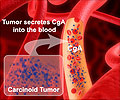
Their results, which appear in the April 25 issue of Cell Reports (available online now), show how a senescent cell may become cancerous if supplied with a new source of nucleotides. Their experiments were performed using nevi—the technical term for moles—and melanoma cells, but the underlying mechanism may apply to all human cells.
"Oncogene-induced senescence is an automatic mechanism that arrests the growth of normal cells when an oncogene or cancer-causing gene is activated to prevent the progression of these cells into cancer," said Rugang Zhang, Ph.D., associate professor in The Wistar Institute Cancer Center's Gene Expression and Regulation program. "We identified how an oncogene can set senescence into motion by suppressing RRM2, an enzyme necessary for producing nucleotides."
Without the nucleotide building blocks of DNA, Zhang says, the cell cannot multiply. When new sources of nucleotides are introduced, however, the cell goes into overdrive, becoming cancerous.
Zhang offers an analogy comparing senescence to a construction site, where workers continue to build as long as they have a steady supply of bricks. When an oncogene is activated, it is like hiring an excess of workers. A normal cell's typical defense mechanism is to cancel orders for new bricks. When all the excess workers quickly run through their supply of bricks, the construction site shuts down. This is essentially senescence. If you suddenly flood the site with new building materials, the workers go into overdrive, building wildly without supervision. In the case of cancer, this causes the cells to put DNA building into overdrive—starting the endless cycles of cell growth and division that are the hallmark of cancer.
To explore how oncogene-induced senescence works, Zhang and his colleagues compared human moles (essentially, pre-cancerous lesions in a senescent state) to cancerous melanoma cells. They found that stable, senescent cells experienced a dramatic decrease in the available number of nucleotides. This was linked to the suppression of RRM2, a gene whose protein is important for making nucleotides. Further, they linked this RRM2 suppression to mutations in BRAF or NRAS, proteins that control the cycle of growth and replication within cells that have been labeled "oncogenes" because their mutation is linked to melanoma and other cancers. Indeed, they report that melanoma patients with high levels of RRM2 fare worse, overall.
Advertisement
"Moles are probably the most visible example of the effect of oncogene-induced senescence in human cells," said Katherine M. Aird, Ph.D., lead author of the study and postdoctoral fellow in the Zhang laboratory at Wistar. "The cells within a mole may have arrested growth, but they are still alive, and may regain activity, even turning cancerous. That is why your dermatologist might tell you to keep an eye on a seemingly benign mole, as changes in its size, color or shape could indicate that it is no longer benign."
Advertisement
"This mechanism also suggests a strategy for patient therapy," Aird explained. "If we can decrease RRM2 activity, it could force tumor cells into a stronger senescent state, perhaps improving the effectiveness of chemotherapy or targeted drugs."
Source-Eurekalert









